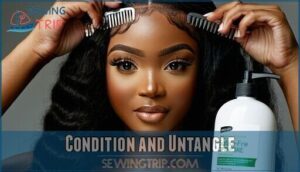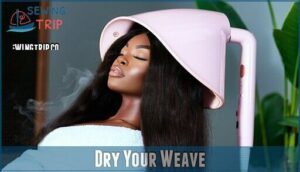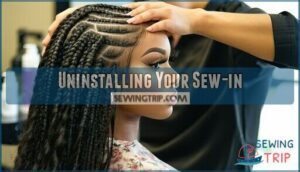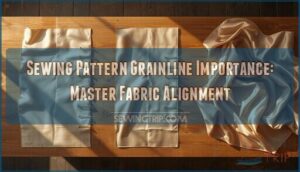This site is supported by our readers. We may earn a commission, at no cost to you, if you purchase through links.
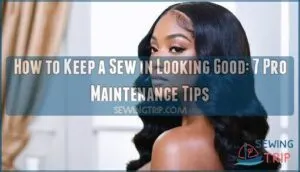 To keep your sew-in looking fresh, you’ll need consistent care that treats both the weave and your natural hair underneath.
To keep your sew-in looking fresh, you’ll need consistent care that treats both the weave and your natural hair underneath.
Start with gentle weekly washing using sulfate-free shampoo, focusing on your scalp while letting suds cleanse the length. Follow with moisturizing conditioner, detangling carefully from ends to roots.
Keep your scalp healthy with lightweight oils and avoid heavy products that cause buildup. Sleep with a silk scarf or bonnet to prevent friction and frizz.
Style with heat protectant when using tools, and don’t overdo tight ponytails that stress the wefts. Professional touch-ups every 4-6 weeks help maintain the install’s integrity.
These fundamentals create the foundation for long-lasting beauty, but mastering the details makes all the difference.
Table Of Contents
Key Takeaways
- Wash your sew-in weekly with sulfate-free shampoo to prevent buildup and keep your scalp healthy – focus on cleansing your scalp directly while letting suds flow down the length
- Sleep with a silk scarf or bonnet every night to prevent friction and frizz, and moisturize your scalp 2-3 times weekly with lightweight oils like jojoba or coconut oil
- Always use heat protectant before styling and keep temperatures low – limit heat styling to under three times weekly and try protective styles like braids or updos instead
- Schedule professional maintenance appointments every 4-6 weeks to check for loose tracks, tighten installation, and catch potential issues before they damage your natural hair
What is a Sew-in Weave?
A sew-in weave transforms your hair game by creating endless styling possibilities.
Your sew-in is the ultimate hair transformation that unlocks limitless styling adventures.
This installation process involves braiding your natural hair into cornrows, then using a needle and thread to attach hair extensions directly onto these braids.
You’re basically building a foundation that’ll support your new look for weeks.
Different sew-in methods work better for various hair types.
Traditional sewin weaves offer maximum coverage, while partial installations let you blend your natural texture with extensions.
The weave variations include net sew-ins for reduced tension and vixen methods for versatile parting.
Hair weaving gives you instant length, volume, and color without permanent changes.
Whether you choose human hair extensions or synthetic options, sew in extensions can last 6-8 weeks with proper care.
To maintain scalp health, consider using scalp massage techniques.
These sewin methods protect your natural hair while you experiment with bold new styles.
Proper Washing and Conditioning Techniques
Keeping your sew-in fresh starts with the right washing routine. You’ll want to cleanse every 7-14 days to prevent buildup and keep your scalp healthy.
Shampoo and Massage Scalp
Everyone deserves clean, healthy hair beneath their sew-in installation.
Start by diluting sulfate-free shampoo with water for easier scalp penetration. Apply directly to your scalp using an applicator bottle, focusing on the hairline and nape where buildup accumulates.
Target your scalp directly with diluted shampoo using an applicator bottle for deep, effective cleansing.
Gently massage in circular motions for improved blood circulation and scalp exfoliation. This gentle cleansing technique prevents track loosening while maintaining proper sew in scalp care.
Rinse thoroughly until water runs clear to avoid residue buildup. Remember to detangle before shampooing to prevent further tangling.
Condition and Untangle
After shampooing, thoroughly saturate your weave with a sulfate-free conditioner, focusing on mid-lengths and ends to avoid loosening the base.
Section your hair into manageable pieces using clips for better control during detangling methods. Start with gentle finger-detangling to work through stubborn knots, then follow with a wide-tooth comb from ends to roots.
This approach prevents shedding and breakage while ensuring proper moisture retention. Avoid heavy products that cause product buildup.
Regular sew in detangling with quality conditioner types keeps your sew in maintenance routine effective for knot prevention and healthy sew in hair care.
To keep your natural hair healthy, remember to focus on proper moisturizing techniques.
Dry Your Weave
After washing through the under-braids of your sew-in, proper hair drying becomes your best defense against mildew prevention and product buildup. Complete drying extends your style’s lifespan while keeping your scalp healthy and odor-free.
- Blot excess water with a microfiber towel before applying heat to reduce overall drying time
- Section your hair and lift tracks gently so cool air reaches every braid underneath
- Use hooded dryers for 30-45 minutes for the most even, thorough results without overheating
- Apply heat protectant before blow-drying on cool settings to prevent extension damage
- Check for dampness in braided areas—any remaining moisture invites mildew and loosens tracks
Your sew in washing routine isn’t complete until hair extensions care includes this essential step.
Consider a gentle drying alternative for delicate weaves. Hair air drying alone won’t penetrate those tight braids, so invest in proper sew in hair care equipment for lasting results.
Moisturizing and Scalp Care
Proper scalp care doesn’t stop after washing—it’s about keeping that foundation moisturized and healthy. Your scalp needs regular attention to prevent dryness and irritation that can sabotage your sew-in.
Apply lightweight, water-based leave-in conditioner every other day using an applicator bottle for precise Hydration Methods. The narrow nozzle helps you target areas between tracks without oversaturating.
For Oil Application, massage natural oils like jojoba or coconut oil into your scalp 2-3 times weekly—these Product Ingredients penetrate better than heavy creams. To soothe irritation, consider tea tree oil.
Try Scalp Exfoliation with gentle circular motions to boost blood flow and remove buildup. Your Nighttime Routine should include light sew in moisturizing before bed. Remember, sew in oiling and scalp care work together—proper moisturizing with quality oils keeps your foundation strong and your weave looking fresh longer.
Styling Tips for a Fresh Look
Now that your scalp’s properly moisturized, let’s talk about keeping your sew-in looking fresh and fabulous. Smart styling keeps your investment looking salon-worthy longer.
Your heat styling approach makes all the difference. Here are three game-changing techniques:
- Use flexi rods or pin curls overnight – creates gorgeous curl definition without damaging heat
- Try the doobie wrap method – stretches hair for sleek, smooth styles that last days
- Switch up your part changes weekly – prevents track exposure and adds instant variety
Always apply heat protectant before using hot tools, and keep temperatures low. Your sew-in care tips should include limiting heat styling to under three times weekly.
Protective styles like braided updos give your hair a break while looking elegant. Mix up your braid variations – try half-up styles, high ponytails, or side-swept looks.
These sew in styling tricks prevent your look from getting stale. Remember, the key to great sew in maintenance isn’t just products – it’s switching up your styling routine to keep things interesting.
Regular Maintenance and Professional Visits
Maintaining your sew-in properly means sticking to a consistent care routine and getting professional help when you need it.
You’ll want to wash your weave weekly and book monthly salon appointments to keep everything looking fresh and secure.
Repeat Wash Routine Weekly
Most sew in maintenance experts recommend weekly washes to combat product buildup and maintain scalp health.
Your wash routine becomes your weave’s best friend—gentle shampooing removes debris while preserving moisture.
Focus on proper drying methods using hooded dryers or cool settings to prevent damage.
Routine customization matters since everyone’s hair needs differ.
Consistent sew in care tips like weekly washing keep your investment looking fresh and your scalp happy, which is the key to maintain scalp health.
Visit The Salon Once a Month for Professional Maintenance
Beyond weekly washing, monthly salon visits are your secret weapon for maintaining that fresh-installed look.
Your cosmetologist performs professional inspection, checking for loose tracks and providing expert advice on sew in maintenance.
They’ll handle track tightening, offer a style refresh, and catch potential issues early for damage prevention.
To keep your sew-in looking its best, remember to wash hair weekly.
These hair appointments keep your investment looking salon-fresh longer.
How to Prevent Common Issues
Even the best sew-in can develop frizz, itching, or tangles without proper prevention. Here’s how to tackle these common issues before they ruin your fresh look.
How to Keep Sew-in From Frizzing
Humidity can turn your sleek sew-in into a frizzy mess faster than you can say "bad hair day." Combat this hair villain with smart frizz prevention strategies that keep your weave looking salon-fresh.
Frizz-Fighting Products and Techniques:
- Use antifrizz serum with silicones before styling to create a moisture barrier
- Sleep with satin wraps for nighttime protection against friction
- Apply humidity control sprays when heading outdoors
- Make certain proper drying with hooded dryers to prevent mildew-related frizz
- Practice avoiding over-washing – limit cleansing to once weekly
Quality hair care for sewins starts with understanding that frizz happens when hair cuticles lift from moisture exposure. Your sew in frizz control routine should include lightweight leave-in conditioners that seal the hair shaft without weighing down your extensions. Remember, consistency beats perfection – stick to these hair humidity defense tactics for lasting results.
To maintain healthy hair, wash hair weekly to prevent issues.
How to Keep Sew-in From Itching
Why does your scalp feel like it’s staging a rebellion? Product buildup and dry skin are the main culprits behind sew in itching prevention issues.
Regular scalp exfoliation and proper oil application keep irritation at bay, especially with synthetic weave material that can trigger allergic reactions.
- Deep cleanse weekly – Use a scalp massager to remove buildup between hair braids
- Apply lightweight oils – Jojoba or tea tree oil directly to exposed scalp areas
- Exfoliate gently – Weekly scalp exfoliation prevents flaky, irritated skin
- Choose quality materials – Invest in 100% human hair to avoid synthetic sensitivities
Proper sew in upkeep and consistent hair care routines eliminate most itching problems before they start.
How to Keep Sew-in From Tangling
Through nighttime protection and gentle detangling techniques, you’ll keep your sew in maintenance routine smooth and tangle-free.
Sleep with a satin cap and pillowcase to reduce friction that causes knots overnight. Before washing, detangle from ends to roots using a wide-tooth comb – this prevents hair extensions from matting when wet.
Product buildup creates tangles, so use sulfate-free shampoos weekly. Extension quality matters too; invest in 100% human hair for better knot prevention.
Daily hair moisture with leave-in conditioner keeps strands smooth. Limit heat styling and never towel-dry roughly to maintain your weave’s longevity.
Uninstalling Your Sew-in
After six to eight weeks, it’s time to bid farewell to your beloved sew-in.
Safe removal prevents hair damage and prepares your scalp for the next fabulous install. Book your stylist for professional weave removal – they’ll carefully cut hair threads and work from bottom to top during the hair takedown process.
Your stylist might suggest overnight oil treatments for buildup prevention, making removal easier on your strands. This hair assessment period reveals any hair matting or damage that needs attention.
Once free, focus on moisture restoration with deep conditioning treatments and scalp treatment to rejuvenate your natural hair after weeks under wraps.
Frequently Asked Questions (FAQs)
How to keep sew in looking fresh?
Keep your sew-in fresh by washing it every 7-14 days with sulfate-free shampoo.
Moisturizing your scalp weekly with oils, and sleeping with a satin bonnet, are also crucial steps.
Visiting your stylist monthly for maintenance is essential to keep your sew-in looking its best.
How to look after a sew in?
Like Sleeping Beauty’s delicate locks, your weave needs gentle care.
Wash every two weeks with sulfate-free shampoo, condition regularly, sleep with satin protection.
Moisturize your scalp weekly, and visit your stylist monthly to ensure your weave remains healthy and well-maintained.
How to prevent hair loss from sew-ins?
Choose gentle braiding tension and avoid tight cornrows that pull your hairline. Remove sew-ins after six weeks maximum to prevent breakage and matting that damages follicles permanently.
How to keep hair moisturized with a sew-in?
Massage hydrating oils like jojoba or coconut oil onto your scalp weekly. Apply leave-in conditioner to extensions and use deep conditioning masks before washing to maintain moisture and prevent dryness.
How long should you wait between sew-in installations?
Professional stylists report that 70% of sew-in damage occurs when installations are back-to-back.
You should wait at least 2-4 weeks between sew-in installations to let your natural hair rest and recover from tension.
Can you swim with a fresh sew-in weave?
Wait at least 48-72 hours before swimming with a fresh sew-in.
The braids and installation need time to settle properly.
Chlorine and saltwater can damage new extensions and loosen tracks before they’re secure.
What products should you avoid with sew-ins?
Skip sulfate-based shampoos, heavy oils, alcohol-based products, and styling gels that cause buildup.
You’ll also want to avoid harsh brushes and products with drying ingredients that strip moisture from your extensions.
How tight should a sew-in feel initially?
Don’t bite off more than you can chew – a properly installed sew-in should feel snug but not painful.
You’ll notice some tension initially, but it shouldn’t cause headaches or extreme discomfort that prevents sleep.
Can you exercise immediately after getting sew-in?
You can exercise lightly after getting a sew-in, but avoid intense workouts for the first 24-48 hours.
Heavy sweating can loosen braids and irritate your scalp while it’s still adjusting to the new tension, which is why it’s crucial to be mindful of your scalp during this period.
Conclusion
Studies show that sew-ins can last up to 12 weeks with proper care, yet many people struggle to maintain theirs beyond 6 weeks.
Now that you’ve learned how to keep a sew in looking good, you’re equipped with professional techniques that’ll extend your weave’s lifespan substantially.
Remember, consistency matters more than perfection.
Weekly washing, regular moisturizing, and gentle handling will keep your investment looking salon-fresh.
Don’t skip those monthly professional maintenance appointments—they’re essential for preventing damage and ensuring your natural hair stays healthy underneath your gorgeous sew-in.
- https://www.tiktok.com//video/7479594488609115438
- https://ladyandthehair.com.au/shampoo-for-hair-extensions/
- https://www.styleseat.com/blog/how-to-wash-a-sew-in/
- https://longhaircareforum.com/threads/how-do-you-clean-your-scalp-while-wearing-a-weave.556619/
- https://www.reddit.com/r/BlackHair/comments/1hmhz80/how_to_wash_sew_ins/


